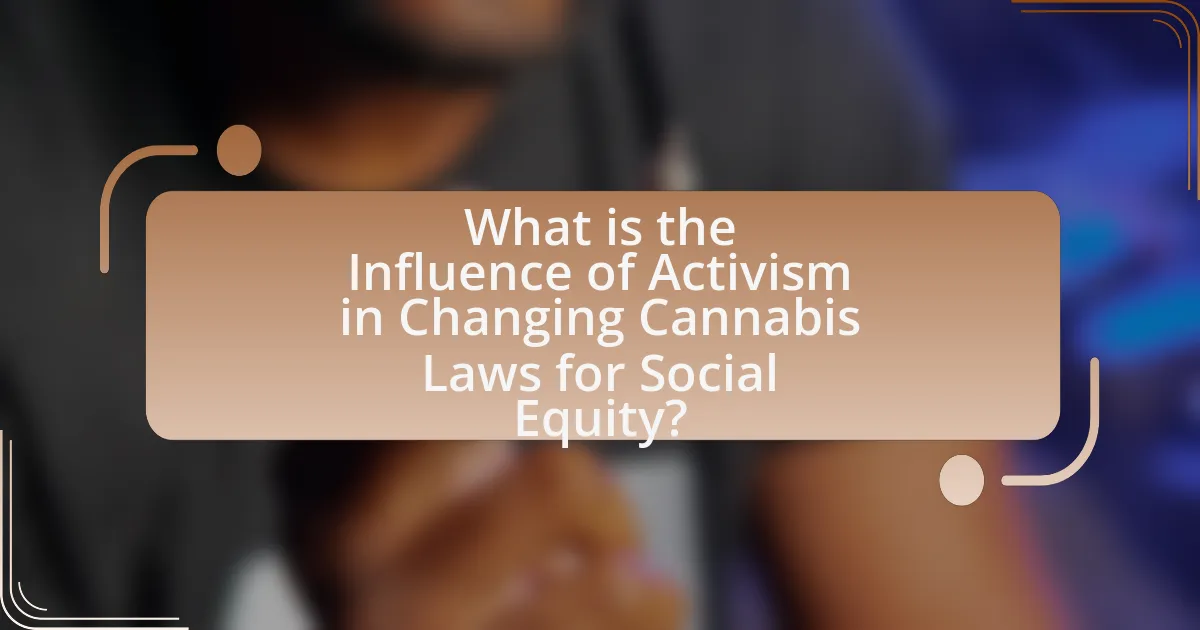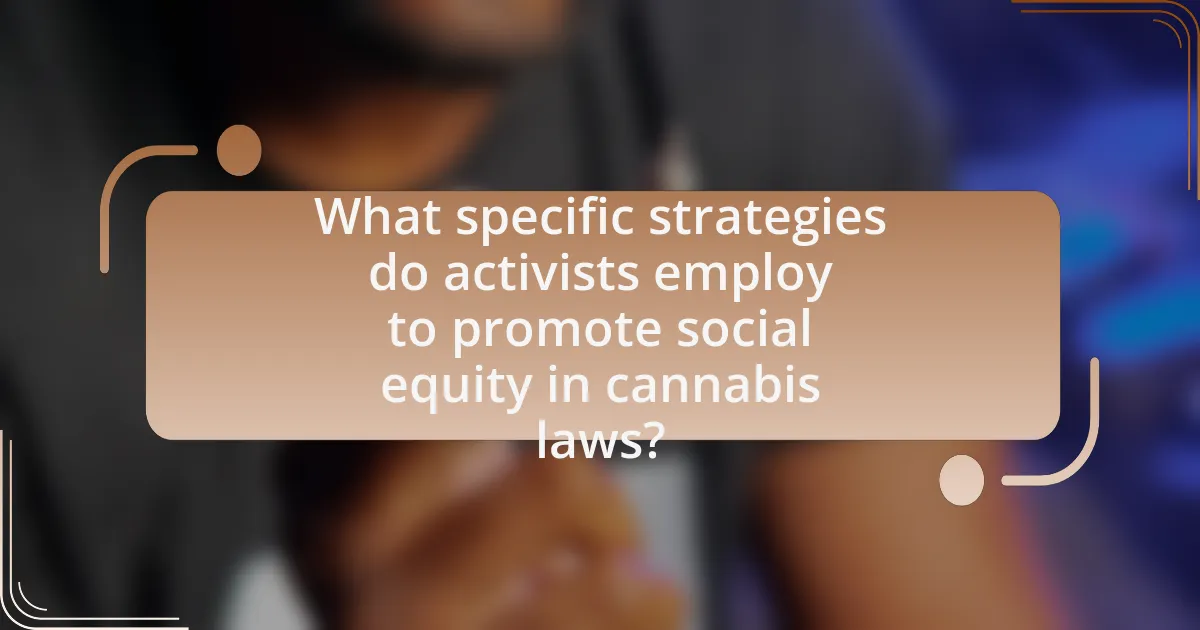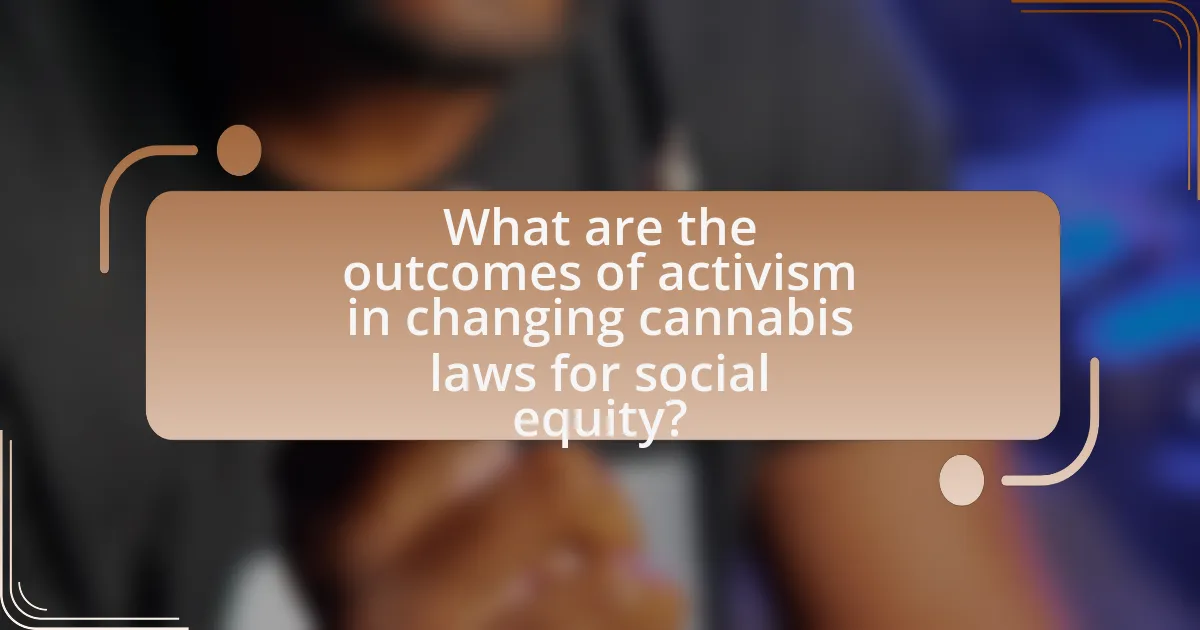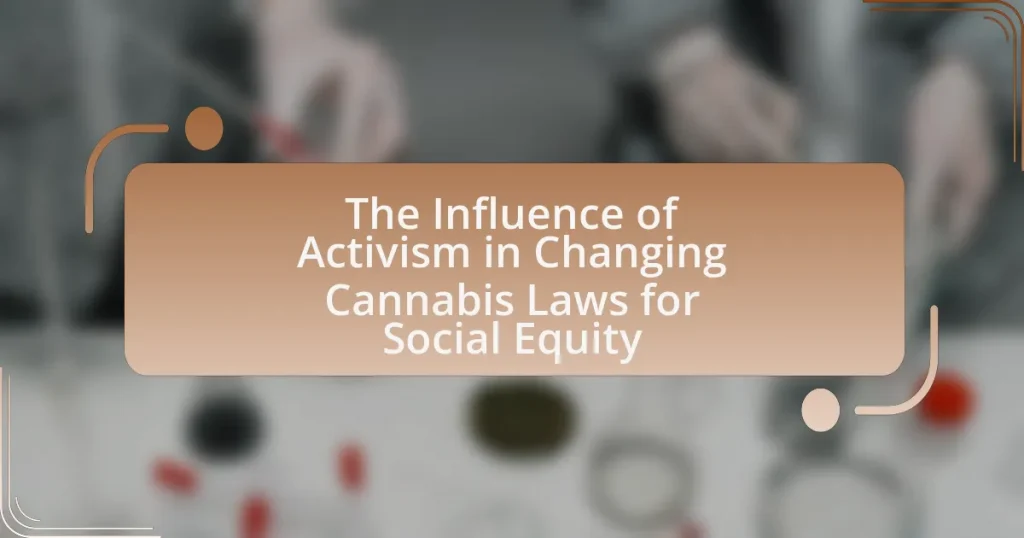The article examines the significant role of activism in shaping cannabis laws with a focus on social equity. It highlights how activists mobilize public support, raise awareness of injustices, and advocate for policy reforms that address the disproportionate impact of cannabis prohibition on marginalized communities. Key historical events, influential organizations, and the challenges faced by activists are discussed, alongside the importance of social equity in rectifying past injustices. The article also explores the strategies employed by activists, the outcomes of their efforts, and the metrics used to assess the effectiveness of cannabis law reforms aimed at promoting equity.

What is the Influence of Activism in Changing Cannabis Laws for Social Equity?
Activism significantly influences the change of cannabis laws for social equity by mobilizing public support, raising awareness about injustices, and advocating for policy reforms. Activists highlight the disproportionate impact of cannabis prohibition on marginalized communities, which has led to increased public discourse and legislative action. For instance, organizations like the Drug Policy Alliance and the National Organization for the Reform of Marijuana Laws have played pivotal roles in advocating for equitable cannabis policies, resulting in states like California and Illinois implementing social equity programs that prioritize the inclusion of individuals from communities adversely affected by past cannabis laws. These efforts have been supported by data showing that Black individuals are nearly four times more likely to be arrested for cannabis-related offenses than white individuals, underscoring the need for reform.
How has activism historically impacted cannabis legislation?
Activism has historically played a crucial role in shaping cannabis legislation by mobilizing public opinion and influencing policymakers. For instance, the 1960s and 1970s saw the emergence of various advocacy groups, such as the National Organization for the Reform of Marijuana Laws (NORML), which campaigned for the decriminalization of cannabis, leading to significant legislative changes in states like California in 1975. Additionally, the medical cannabis movement, particularly in the 1990s, was driven by activists who highlighted the therapeutic benefits of cannabis, resulting in states like California legalizing medical use in 1996. These efforts have contributed to a broader shift in societal attitudes towards cannabis, ultimately leading to the legalization of recreational use in several states by the 2010s, reflecting the impact of sustained activism on cannabis policy reform.
What key events have marked the evolution of cannabis laws through activism?
Key events that have marked the evolution of cannabis laws through activism include the formation of the National Organization for the Reform of Marijuana Laws (NORML) in 1970, which advocated for the decriminalization of cannabis, and the passage of California’s Proposition 215 in 1996, the first state law to legalize medical cannabis. These events were pivotal as they mobilized public support and influenced legislative changes across the United States. Additionally, the legalization efforts in Colorado and Washington in 2012 set a precedent for recreational cannabis laws, demonstrating the impact of grassroots activism on policy reform. The ongoing advocacy for social equity in cannabis legislation, particularly following the legalization movements, has further highlighted the role of activism in addressing historical injustices related to cannabis prohibition.
How have different activist groups contributed to changes in cannabis laws?
Different activist groups have significantly contributed to changes in cannabis laws by advocating for legalization, decriminalization, and social equity measures. Organizations such as the Drug Policy Alliance and NORML (National Organization for the Reform of Marijuana Laws) have mobilized public support, lobbied legislators, and provided research to demonstrate the benefits of cannabis reform. For instance, the Drug Policy Alliance’s campaigns have led to the legalization of cannabis in several states, including California in 2016, where Proposition 64 was passed, reflecting a shift in public opinion influenced by activist efforts. Additionally, groups focused on social equity, like the Last Prisoner Project, have highlighted the injustices faced by communities disproportionately affected by cannabis prohibition, pushing for policies that include expungement of criminal records and equitable access to the legal cannabis market. These collective actions have resulted in a more favorable legal landscape for cannabis across various jurisdictions.
Why is social equity a critical aspect of cannabis law reform?
Social equity is a critical aspect of cannabis law reform because it addresses the historical injustices and disparities caused by the War on Drugs, which disproportionately affected marginalized communities. Research indicates that Black and Latino individuals are significantly more likely to be arrested for cannabis-related offenses despite similar usage rates compared to white individuals. For instance, a 2020 report from the American Civil Liberties Union found that Black people are nearly four times more likely to be arrested for cannabis possession than white people, highlighting systemic racial biases in enforcement. By incorporating social equity into cannabis law reform, policymakers aim to rectify these injustices, promote inclusive economic opportunities, and ensure that communities harmed by past drug policies can benefit from the legal cannabis market.
What are the historical injustices related to cannabis prohibition?
Historical injustices related to cannabis prohibition include systemic racial discrimination, wrongful incarceration, and economic disenfranchisement. The War on Drugs, initiated in the 1970s, disproportionately targeted Black and Latino communities, leading to higher arrest rates for cannabis offenses despite similar usage rates among racial groups. For instance, a 2013 report by the American Civil Liberties Union revealed that Black individuals were nearly four times more likely to be arrested for cannabis possession than white individuals, highlighting the racial disparities in enforcement. Additionally, the criminalization of cannabis has resulted in millions of individuals facing felony charges, which severely limits their access to employment, housing, and education, perpetuating cycles of poverty and inequality. These injustices underscore the need for reform and social equity in cannabis legislation.
How do current cannabis laws affect marginalized communities?
Current cannabis laws disproportionately affect marginalized communities by perpetuating systemic inequalities and hindering economic opportunities. Research indicates that despite similar usage rates, individuals from marginalized backgrounds face higher arrest rates for cannabis-related offenses; for example, Black individuals are nearly four times more likely to be arrested for cannabis possession than their white counterparts, according to the American Civil Liberties Union (ACLU). Additionally, restrictive cannabis regulations often limit access to legal markets for these communities, preventing them from benefiting economically from legalization. This lack of access is compounded by historical injustices, where marginalized groups have been disproportionately targeted by law enforcement, leading to long-lasting social and economic repercussions.
What role do public perceptions play in the activism for cannabis law changes?
Public perceptions significantly influence activism for cannabis law changes by shaping the political landscape and public policy. When a majority of the population views cannabis use positively, it creates a favorable environment for activists to advocate for reform. For instance, a 2021 Gallup poll indicated that 68% of Americans support legalizing cannabis, reflecting a shift in public opinion that has led to legislative changes in numerous states. This growing acceptance encourages lawmakers to respond to constituents’ views, thereby facilitating the passage of more progressive cannabis laws. Additionally, public perceptions can mobilize grassroots movements, as seen in campaigns that highlight the social equity implications of cannabis legalization, further driving the demand for reform.
How has media coverage influenced public opinion on cannabis reform?
Media coverage has significantly influenced public opinion on cannabis reform by shaping perceptions and increasing awareness of the issues surrounding cannabis legalization. For instance, extensive reporting on the benefits of legalization, such as economic growth and social justice, has contributed to a shift in public attitudes, with a Gallup poll in 2021 indicating that 68% of Americans support legalizing cannabis, a record high. Furthermore, media narratives that highlight personal stories of individuals affected by cannabis laws have humanized the issue, fostering empathy and support for reform. This coverage has also played a role in countering stigma, as studies show that positive media portrayals correlate with increased public acceptance of cannabis use and policy changes.
What strategies do activists use to shift public perceptions?
Activists employ various strategies to shift public perceptions, including grassroots mobilization, social media campaigns, and educational outreach. Grassroots mobilization involves organizing community events and protests to raise awareness and demonstrate public support for cannabis law reform. Social media campaigns leverage platforms like Twitter and Instagram to disseminate information, share personal stories, and engage with a broader audience, effectively changing narratives around cannabis use. Educational outreach focuses on providing factual information about the benefits of cannabis legalization and its impact on social equity, often supported by research studies that highlight disparities in enforcement and access. For instance, a report by the American Civil Liberties Union (ACLU) indicates that Black individuals are nearly four times more likely to be arrested for cannabis possession than white individuals, which activists use to advocate for equitable policy changes.
How does activism connect to the legislative process for cannabis reform?
Activism directly influences the legislative process for cannabis reform by mobilizing public support and advocating for policy changes. Activists raise awareness about the social, economic, and health impacts of cannabis prohibition, which can lead to increased public pressure on lawmakers. For instance, organizations like the Marijuana Policy Project have successfully lobbied for the legalization of cannabis in multiple states, demonstrating how grassroots campaigns can result in legislative action. Additionally, data from the 2020 election showed that states with strong activist movements, such as California and Illinois, passed significant cannabis reform measures, highlighting the correlation between activism and legislative outcomes.
What are the challenges activists face in advocating for cannabis law changes?
Activists face significant challenges in advocating for cannabis law changes, primarily due to legal barriers, societal stigma, and political opposition. Legal barriers include existing federal and state laws that criminalize cannabis use, making it difficult for activists to push for reform. Societal stigma surrounding cannabis persists, often leading to public resistance against legalization efforts. Political opposition arises from lawmakers who may prioritize other issues or hold anti-cannabis views, complicating the legislative process. For instance, despite growing public support for cannabis legalization, as evidenced by a 2021 Gallup poll showing 68% of Americans favoring legalization, many politicians remain hesitant to act due to fear of backlash from constituents or party affiliations.

What specific strategies do activists employ to promote social equity in cannabis laws?
Activists employ several specific strategies to promote social equity in cannabis laws, including advocacy for policy reform, community engagement, and legal assistance. Advocacy for policy reform involves lobbying lawmakers to create equitable legislation that addresses the historical injustices of cannabis prohibition, such as expunging criminal records for past cannabis offenses. Community engagement focuses on educating affected communities about their rights and the benefits of legalization, often through workshops and outreach programs. Legal assistance is provided to help individuals navigate the complexities of cannabis laws, ensuring that marginalized groups can access the legal cannabis market. These strategies are supported by data showing that states with social equity programs have seen increased participation from historically marginalized communities in the cannabis industry, highlighting the effectiveness of these activist efforts.
How do grassroots movements contribute to cannabis law reform?
Grassroots movements significantly contribute to cannabis law reform by mobilizing community support, raising awareness, and influencing policymakers. These movements often consist of local activists who advocate for changes in legislation through campaigns, petitions, and public demonstrations. For instance, the legalization of cannabis in states like Colorado and California was largely driven by grassroots organizations that educated the public on the benefits of legalization and the injustices of prohibition. Research indicates that states with strong grassroots advocacy saw a higher likelihood of passing cannabis reform measures, demonstrating the effectiveness of community-driven efforts in shaping policy.
What are some successful examples of grassroots activism in cannabis reform?
Successful examples of grassroots activism in cannabis reform include the legalization efforts in Colorado and Washington, which were driven by local advocacy groups like the Campaign to Regulate Marijuana Like Alcohol and Sensible Washington. These organizations mobilized community support, gathered signatures for ballot initiatives, and educated the public on the benefits of legalization. In 2012, Colorado’s Amendment 64 passed with 55.3% of the vote, while Washington’s Initiative 502 received 55.7% approval, demonstrating the effectiveness of grassroots campaigns in influencing cannabis policy. Additionally, the Drug Policy Alliance has played a significant role in advocating for social equity in cannabis laws, pushing for reforms that address the disproportionate impact of drug enforcement on marginalized communities.
How do grassroots movements engage with local communities?
Grassroots movements engage with local communities by fostering direct participation and collaboration in advocacy efforts. These movements often organize community meetings, workshops, and events to educate residents about issues, such as cannabis laws, that affect them directly. For instance, the Drug Policy Alliance has been instrumental in mobilizing local communities to advocate for equitable cannabis policies, emphasizing the importance of community voices in shaping legislation. By utilizing social media and local networks, grassroots movements can amplify their message and encourage community members to share their experiences, thereby creating a collective narrative that influences policymakers.
What role do coalitions and partnerships play in cannabis activism?
Coalitions and partnerships are crucial in cannabis activism as they amplify voices, unify efforts, and enhance resource sharing among diverse stakeholders. By collaborating, organizations can combine expertise, mobilize larger groups, and create a more significant impact on policy changes. For instance, the coalition formed by the National Organization for the Reform of Marijuana Laws (NORML) and the Drug Policy Alliance has successfully advocated for legislative reforms in multiple states, demonstrating the effectiveness of collective action in achieving social equity in cannabis laws.
How do collaborations enhance the effectiveness of cannabis law advocacy?
Collaborations enhance the effectiveness of cannabis law advocacy by pooling resources, expertise, and networks among diverse stakeholders. When advocacy groups, legal experts, and community organizations work together, they can create a unified front that amplifies their message and increases visibility. For instance, joint campaigns can leverage the strengths of each partner, such as grassroots mobilization from community organizations and legal knowledge from law firms, leading to more comprehensive strategies. Research shows that coalitions can improve legislative outcomes; a study by the Drug Policy Alliance found that collaborative efforts significantly increased the likelihood of passing cannabis reform bills in various states. This collective approach not only strengthens advocacy efforts but also fosters a more inclusive dialogue around social equity in cannabis laws.
What are some notable coalitions focused on cannabis social equity?
Notable coalitions focused on cannabis social equity include the Equity First Alliance, the National Cannabis Industry Association’s (NCIA) Diversity, Equity, and Inclusion Committee, and the Last Prisoner Project. The Equity First Alliance aims to ensure that communities disproportionately affected by cannabis prohibition benefit from legalization. The NCIA’s committee works to promote diversity and equity within the cannabis industry, advocating for policies that support underrepresented groups. The Last Prisoner Project focuses on criminal justice reform and the release of individuals incarcerated for cannabis-related offenses, emphasizing the need for restorative justice in the cannabis space. These coalitions collectively address the historical injustices of cannabis prohibition and advocate for equitable access to the legal cannabis market.

What are the outcomes of activism in changing cannabis laws for social equity?
Activism has led to significant outcomes in changing cannabis laws for social equity, including the implementation of policies aimed at reducing disparities in cannabis-related arrests and promoting equitable access to the legal cannabis market. For instance, states like California and Illinois have enacted social equity programs that prioritize licenses for individuals from communities disproportionately affected by cannabis prohibition. Research from the Drug Policy Alliance indicates that these programs can help rectify historical injustices by providing financial assistance and training to marginalized groups. Additionally, activism has raised public awareness about the racial disparities in cannabis enforcement, leading to legislative reforms that decriminalize cannabis and expunge past convictions, further promoting social equity.
What legislative changes have resulted from activist efforts?
Legislative changes resulting from activist efforts in cannabis laws include the legalization of recreational and medical cannabis in various states, such as California’s Proposition 64 in 2016 and Illinois’ legalization in 2019. These changes were driven by grassroots movements advocating for social equity, criminal justice reform, and public health. For instance, California’s law included provisions for expunging past cannabis convictions, reflecting the influence of activists who highlighted the disproportionate impact of cannabis prohibition on marginalized communities. Additionally, the establishment of social equity programs in states like Massachusetts aims to provide opportunities for those adversely affected by past cannabis laws, further demonstrating the tangible outcomes of activist efforts in shaping legislation.
How have these changes impacted social equity in cannabis access?
Changes in cannabis laws have significantly improved social equity in cannabis access by reducing barriers for marginalized communities. Legalization efforts, often driven by activism, have led to the establishment of social equity programs that prioritize licenses for individuals from communities disproportionately affected by past drug policies. For instance, states like California and Illinois have implemented measures that provide financial assistance and training for applicants from these communities, aiming to rectify historical injustices. Additionally, data from the Marijuana Policy Project indicates that states with social equity initiatives have seen increased participation from minority-owned businesses in the cannabis industry, further promoting equitable access.
What metrics can be used to measure the success of these legislative changes?
Metrics to measure the success of legislative changes in cannabis laws for social equity include the reduction in arrest rates for cannabis-related offenses, the increase in minority-owned cannabis businesses, and the allocation of tax revenue from cannabis sales to community programs. For instance, states like California have reported a significant decrease in arrests, with a 56% drop in cannabis-related arrests following legalization, indicating a positive impact on social equity. Additionally, tracking the percentage of cannabis licenses awarded to minority applicants can provide insight into economic opportunities created by these legislative changes. Furthermore, evaluating the funding directed towards social equity initiatives, such as drug treatment programs and community reinvestment, can serve as a critical metric for assessing the overall effectiveness of the laws.
How do activists assess the effectiveness of their campaigns?
Activists assess the effectiveness of their campaigns by measuring specific outcomes against their initial goals. They often utilize metrics such as changes in public opinion, legislative outcomes, and increased awareness of issues related to cannabis laws and social equity. For instance, a campaign may track the number of new laws passed that promote social equity in cannabis distribution, or analyze survey data showing shifts in public support for these laws. Additionally, activists may evaluate engagement levels through social media metrics, attendance at events, and participation in advocacy efforts, providing concrete evidence of their campaign’s impact.
What tools and methods do activists use for evaluation?
Activists use a variety of tools and methods for evaluation, including surveys, focus groups, data analysis, and case studies. Surveys allow activists to gather quantitative data on public opinion and the effectiveness of their campaigns, while focus groups provide qualitative insights into community perceptions and experiences. Data analysis helps activists assess the impact of policy changes on social equity, and case studies offer detailed examinations of specific instances of activism and their outcomes. These methods are supported by evidence from successful campaigns that demonstrate their effectiveness in measuring progress and informing future strategies.
How can lessons learned from past campaigns inform future activism?
Lessons learned from past campaigns can significantly inform future activism by providing insights into effective strategies, messaging, and coalition-building. For instance, the successful legalization efforts in states like Colorado and Washington demonstrated the importance of grassroots mobilization and targeted outreach to diverse communities. These campaigns utilized data-driven approaches to highlight the social equity implications of cannabis laws, which can guide future activists in framing their arguments. Additionally, analyzing the failures of previous campaigns, such as those that lacked broad public support or failed to address social justice issues, can help activists avoid similar pitfalls. Historical examples show that campaigns which effectively engaged with marginalized communities and emphasized the benefits of legalization for social equity were more successful, underscoring the need for inclusivity in future efforts.
What best practices can activists adopt for effective advocacy in cannabis law reform?
Activists can adopt several best practices for effective advocacy in cannabis law reform, including building coalitions, utilizing data-driven arguments, and engaging in grassroots mobilization. Building coalitions with diverse stakeholders, such as health professionals, legal experts, and affected communities, enhances credibility and broadens support. Utilizing data-driven arguments, such as statistics on the economic benefits of legalization or the social justice implications of criminalization, strengthens the case for reform. Grassroots mobilization, including organizing community events and leveraging social media, fosters public engagement and raises awareness about the issues at hand. These practices have been shown to increase the likelihood of successful legislative outcomes, as evidenced by the growing number of states that have reformed cannabis laws in response to organized advocacy efforts.

